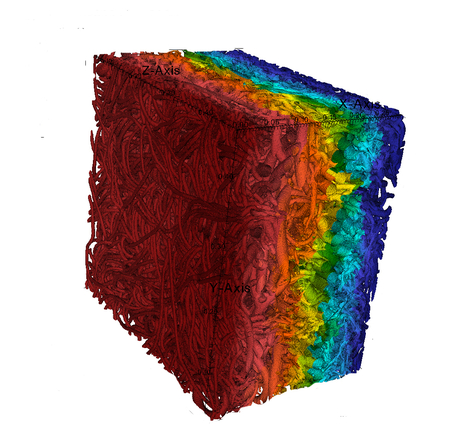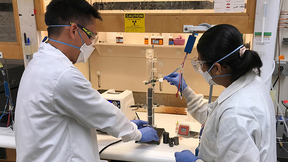LLNL and LBNL researchers explore more energy-efficient solutions for paper industry
 (Download Image)
This image depicts a simulation of pressure applied to felt used to absorb water in a paper drying process. Photo courtesy of David Trebotich/Lawrence Berkeley National Laboratory.
(Download Image)
This image depicts a simulation of pressure applied to felt used to absorb water in a paper drying process. Photo courtesy of David Trebotich/Lawrence Berkeley National Laboratory.
If you had to name the industries in the United States that use the most energy, paper manufacturing probably wouldn’t immediately come to mind. In fact, the paper-making industry ranks third among the country’s largest energy users, behind only petroleum-refining and chemical production, according to the U.S. Energy Information Administration.
Researchers at Lawrence Livermore (LLNL) and Lawrence Berkeley (LBNL) national laboratories are using the national labs’ supercomputing capabilities to look at more energy efficient and cost-saving ways to make paper, targeting "wet-pressing," the stage where water is removed by mechanical pressure from the wood pulp into press felts that help soak up water before it is sent through a drying process. The researchers hope to develop a model for flow and deformation of the wet porous paper during the process, saving both energy and money. The project is one of the seedlings for the Department of Energy’s HPC4Mfg initiative, a multi-lab effort headed by LLNL to use high-performance computing to address complex challenges in U.S. manufacturing.
"The major purpose is to leverage our advanced simulation capabilities, high performance computing (HPC) resources and industry paper press data to help develop integrated models to accurately simulate the water papering process," said Yue Hao, an LLNL scientist and a co-principal investigator on the project. "If we can increase the paper dryness after pressing and before the drying (stage), that would provide the opportunity for the paper industry to save energy."
The team recently released its final report on the first phase of the pilot project for the Agenda 2020 Technology Alliance, a consortium of paper manufacturers with a roadmap to reduce their energy usage by 20 percent by 2020. Hao said if manufacturers could increase the paper’s dryness by 10 percent to 15 percent, it would save paper manufacturers up to 20 percent of the energy used in the drying -- up to 80 trillion BTU’s (thermal energy units) per year and as much as $250 million for the industry annually.
Admittedly, Hao said, improving the dewatering process is no easy task, but by leveraging the DOE national laboratories’ advanced simulation capabilities and HPC resources, along with sufficient experimental measurements and paper machine data, they feel confident they can develop the computational models needed to optimize paper press processes and achieve the goals set by Agenda 2020.
"The scientific challenge is that we need to develop a fundamental understanding of how water flows and migrates," Hao said. "All the physical phenomena involved make this problem a tough one because the dewatering process isn’t fully understood due to a lack of sufficient data. This is a collective effort and we really need every piece of the contribution."
LLNL developed the simulation framework integrating mechanical deformation and two-phase flow models, while LBNL developed a full-scale microscale flow model for the complex pore structures in the press felts utilizing sophisticated modeling capabilities.
"This was true ‘HPC for manufacturing,’" said David Trebotich, a computational scientist in the Computational Research Division at LBNL and co-principal investigator on the project. "We used 50,000-60,000 cores at NERSC (National Energy Research Scientific Computing Center) to do these simulations. It’s one thing to take a research code and tune it for a specific application, but it’s another thing to make it effective for industry purposes. Through this project, we have been able to help engineering-scale models be more accurate by informing better parameterizations from micro-scale data."
Researchers said in order to create a more accurate and reliable computational model and develop a better understanding of a complex phenomenon, they would need to acquire more complete data from the industry such as paper material properties, high-resolution micro-CT images of paper and experimental data derived from scientifically-controlled dewatering tests.
The study was conducted with funding from the Department of Energy’s Advanced Manufacturing Office within the Energy Efficiency and Renewable Energy Office. Other researchers on the project include Wei Wang of Lawrence Livermore and Jun Xu and David Turpin of Agenda 2020.
Contact
 Jeremy Thomas
Jeremy Thomas
[email protected]
(925) 422-5539
Related Links
HPC4MfgHPC4Mfg Seedlings Project
Tags
EngineeringEconomic Impact
Featured Articles







